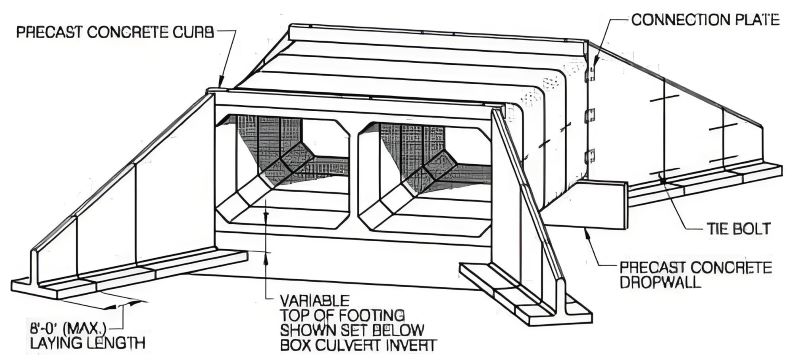A road culvert isn’t just “a pipe under a road” – it’s a carefully engineered structure made up of several interrelated components designed to safely convey water while supporting the roadway above. Although culvert designs can vary by type (pipe, box, arch, etc.) and materials (concrete, metal, HDPE, and more), the following components are commonly found in many road culvert systems:

1. Inlet
The inlet is the entry point for water into the culvert. Its design is critical because it influences hydraulic efficiency and debris control. Inlet configurations can vary—examples include projecting inlets, flush (or mitered) inlets, and those with headwalls—to best match site conditions and to direct water smoothly into the barrel. Poorly designed inlets can increase headwater depth or allow debris to plug the system.
2. Culvert Barrel
This is the main channel or “pipe” through which water flows. The barrel can be circular, box-shaped, elliptical, or arch-shaped. It is designed not only to carry water but also to withstand the structural loads imposed by the roadway above. The material and shape chosen affect both the hydraulic capacity and the durability of the culvert.
3. Outlet
At the other end, the outlet is the point where water leaves the culvert. Its design ensures that water discharges into the downstream channel or drainage system without causing excessive erosion or hydraulic problems.
4. Headwall
A headwall is typically constructed at the inlet (and sometimes at the outlet) and serves several functions: it helps to direct water into the culvert, provides support against the lateral pressures of soil and water, and minimizes erosion at the approach to the culvert.
5. Wingwall
Often paired with the headwall, wingwalls extend laterally from the culvert. They help funnel water into the inlet and stabilize the embankment by retaining soil and mitigating erosion.
6. Apron (or Base/Bottom Slab)
An apron is a horizontal extension (often at the inlet or outlet) that acts as a protective layer. It helps dissipate energy, spreads the loads from the roadway above, and reduces the risk of scour at the interface between the culvert and the natural channel.
7. Crown and Invert
- Crown: The crown is the top surface of the culvert barrel. It is engineered to resist the vertical loads from traffic and the overlying embankment.
- Invert: The invert is the lowest interior surface of the culvert. It defines the effective flow channel and is a critical reference for hydraulic design calculations.
Both elements help determine the hydraulic capacity of the culvert and ensure proper water conveyance.
8. Foundation (Bedding)
While not a part of the culvert “body” itself, the foundation or bedding is crucial. This prepared base supports the culvert, ensuring it is properly aligned and that the loads from the road are evenly distributed into the underlying soil or rock.
9. Roadway Components (Embankment/Pavement)
Though these aren’t components of the culvert per se, the roadway embankment and pavement are integrally related. They protect the culvert, help direct surface runoff to its inlet, and must be designed to work in concert with the culvert system.
Each of these components plays a vital role in the overall performance of a road culvert—from controlling water flow and managing debris to resisting structural loads and preventing erosion. The specific design details (such as the choice between a circular pipe and a box culvert) depend on site conditions, hydraulic requirements, and budget considerations.




